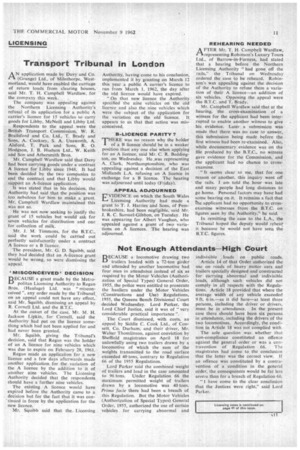Not Enough Attendants—High Court
Page 13

If you've noticed an error in this article please click here to report it so we can fix it.
BECAUSE a locomotive drawing two .1-1 trailers loaded with a 72-ton girder and attended by another locomotive had four men in attendance instead of six as required by the Motor Vehicles (Authorization of Special Types) General Order, 1955, the police were entitled to prosecute the hauliers under the Motor Vehicles (Constructions and Use) Regulations, 1955, the Queens Bench Divisional Court decided Wednesday. Lord Parker, the Lord Chief Justice, said it was of "very considerable practical importance".
The Court dismissed, with costs, an appeal, by Siddle C. Cook Ltd., of Consett, Co. Durham, and their driver, Mr. Walter Thomlinson, against conviction by Sheffield magistrates on April 18 for unlawfully using two trailers drawn by a locomotive of which the sum of the weights transmitted to the road surface exceeded 40 tons, contrary to Regulation 66 of the 1955 Regulations, Lord Parker said the combined weight of trailers and load in the case amounted to 96 tons. Under Regulation 66 the maximum permitted weight of trailers drawn by a locomotive was 40 tons. Prima facie there had been a breach of this Regulation. But the Motor Vehicles (Authorization of Special Types) General Order, 1955, authorized the use of certain vehicles for carrying abnormal and
indivisible loads on public roads.
Article 14 of that Order authorized the use on roads of heavy motor cars and trailers specially designed and constructed for carrying abnormal and indivisible loads, although such vehicles did not comply in all respects with the Regulations. Article 18 provided that where the average width of any vehicle exceeded 9 ft. 6 in.—as it did here—at least three persons, including the driver or drivers, must be in attendance. In the present case there should have been six persons in attendance, including the drivers of the two locomotives. Accordingly, the condition in Article 18 was not complied with The sole question was whether that non-compliance constituted an offence against the general order or was a contravention of Regulation 66. The magistrates had come to the conclusion , that the latter was the correct view. If an offence was constituted by a contravention of a condition in the general order, the consequences would be far less severe than for a breach of Regulation 66.
"I have come to the clear conclusion that the Justices were right," said Lord Parker.












































































































